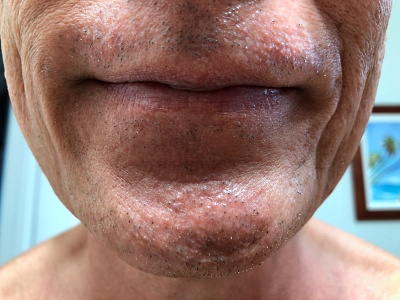Okay, how about “The 5 things that I’ve found that actually work to help me play the trumpet better”? TL;DR? Maybe, but bear with me. These are 5 things that all the research, all the YouTubes, all the research papers seem to hint at, mention, but didn’t just say, “Do this, and your trumpet playing will improve.
How do I fix my trumpet embouchure?
Why are we here? I have spent countless days researching, watching, listening, and taking lessons from professional trumpet teachers. I’m trying not to smile. When I play the trumpet that is. I’m trying to fix my embouchure. Just one question. Why is this SO hard?
How long do you have? I started this journey to learn to play the trumpet. As someone that played long ago, I assumed (wrongly) that it should be easier than when I started. Ha !
I studied all the forums, websites, and YouTubes. There was WAY too much information out there. A lot of it conflicting stuff too. Tip: Don’t ever ask about tongue arch. Lots of differing opinions on that one. So I decided to look for what are the common things that were said. You know, looking for what I had hoped were “fundamentals” or common things published about the trumpet or brass embouchure. After going down side mission after side mission, I made an earth-shattering discovery. Ready? It is that everyone is different. Duh.
How so?
- Our teeth alignment, position, overbite, etc.
- The muscular development of our faces is different.
But mostly, how we are introduced to the trumpet (or cornet in my case). The compensations that come in the absence of good instruction. All different. I keep peeling back the layers on this Ogre and found that the basic things about the brass embouchure are out there.
What is “Embouchure”?
I “played” the trumpet from age 12 to 18. Like many, I started with a cornet. Like many, learned from a public, middle school band teacher. There was one assistant. They had to teach some 35 kids all the different instruments so my introduction to the trumpet was “here’s a mouthpiece, buzz it”. How? “Use your face”. Sounds easy enough. Really? No. This use of your face is called your embouchure. It’s a French word that means “river mouth”. Or in my case, “flopping on the ground fish face”. Not sure if Google Translate got that right.
Brass Embouchure Fundamentals
What are the 5 fundamentals that are most commonly said?
- Say “Emm”. Or “M”.
- Place the mouthpiece gently, equally on the top and bottom lip.
- Have a space between your top and bottom teeth.
- Wet your lips.
- Hold the corners of your mouth.

Brass Embouchure Mistakes

Stuff that we aren’t supposed to do, but why?
- Smile. That pulls the lips taut using the cheek muscles. While this will “work”, it has limitations in terms of range and endurance. That’s what I’m trying to unlearn.
- Lots of Mouthpiece pressure. You need enough pressure, so the mouthpiece forms a seal around your lips. If you are using mouthpiece pressure to help create tautness in your lips, you could hurt yourself. Think how strong your arm muscles are, pulling a piece of metal against your face. Please don’t hurt yourself. This is supposed to be fun.
- Peach pit chin. What? That’s where you pull your chin up. So the middle of your chin bunches up. Instead, you should think about pointing or extending the bottom of your chin downward. This is explained down below.
- Don’t puff the cheeks. Sure, Dizzy did it. If you can play like Dizzy, go for it.
Brass Embouchure Secrets.
The sayings like “Wet your lips”. Why? Why do we do these things? Glad you asked.
- When you say “Emm”, the corners of your mouth should be held taut or firm or however you can describe it. Why? It’s what holds the muscles of your lips in position against your teeth. The corners control your aperture (more later).
- Even though the mouthpiece is placed 50/50 on your lips top/bottom, is the pressure equal too? Your lower lip can accept more pressure. Like 40% of the mouthpiece pressure on the top and 60% on the bottom. Why? It’s because you want your upper lip to be free to vibrate. This makes a big difference in endurance, tone, and range for me.
- The space between your teeth is created by lowering your jaw. BUT, and for me this was a big one. The bottom and the top teeth edges should be aligned by extending your jaw forward. Why? I have a slight overbite, so I only have to move my lower jaw out a little, like ¼ inch. The lower jaw and the muscles that let us talk, chew, etc. are very strong. By holding the jaw in place and letting it take more of the mouthpiece pressure, it really made a difference. The lower lip and jaw muscles are so much stronger that my upper lip doesn’t get tired so fast.
- It’s actually not the whole lip that vibrates. At least not for the trumpet. It’s the skin between them that does. And by wetting it, it creates surface tension that your air will make it vibrate. Okay, maybe I’m the last to learn this.
- As someone that used to use the “Smile” embouchure, I held my lips in position with my cheeks. I think it was a side to side model of tension. I’m trying to think up and down. Meaning, use the levator labii superioris muscles that lift the upper lip and extending my chin down to put tension on my lower lip. It’s not a 180-degree swap, more like a 90 degree change. But it’s still completely different.
How to use your embouchure
Okay. Now that we know the “What” to do and the “Why” we do it. And, we know what not to do and why we shouldn’t do those things. How do we use our brass embouchure? How do we apply this to trumpet playing? A guitar string is great example to think about for changing pitch when we play the trumpet. When you tighten the thingy (that’s a technical term) on top, it makes the string tighter. When you strum the string, it vibrates at a higher frequency. So too must our lips have some tension to play higher notes. That tension being to hold the lips in position against the air stream. The difference between a C below the staff and one above the staff is our lips vibrating at a higher frequency. So there is more tension within our embouchure to create those higher frequency of vibration. Notice I didn’t say “lips”. The reason our embouchure produces tension is that if we just tightened up and/or mashed our lips together, nothing would come out. The vibrating surfaces between our lips, is called the “aperture” or “aperture tunnel”, needs to be open to let the air stream flow. Yes, I’ve read way too many research papers. This one is from a PhD French horn player.
The softer the lips around the aperture or hole between our lips, the slower the vibrations can be. That’s why we relax to play pedal tones for example. The firmer the lips around the aperture, the faster the vibrations can be. Think about the water that comes out of a hose you use to water your yard. Now put your thumb over part of the end making the exit smaller. The water comes out faster right? Same for our air when we play the trumpet. By firming up the aperture of our embouchure, the air can move faster with the same support. Same air, but it’s just faster as too are the vibrations of the aperture. See timecode 57:50 in Charlie’s video on the bottom of this post, “How to Practice…”.
Charlie does a great job of explaining why our embouchure works the way it does. When I first watched this video, I didn’t understand what he was trying to tell me. How about you? Bet you got a ton from it? The water hose analogy above falls apart in that the nozzle is solid, like metal. Our lips are not. We increase the tension of the aperture to make the air go faster and to resist the faster air flow. This is why just blowing harder doesn’t make your notes go higher. You add tension in your lips that is like tightening the tuning knob on the guitar string. When the levator labii superioris muscles are engaged, they lift the upper lip. By holding the corners of your mouth in place, your upper lip is pulled tighter against your upper teeth. If you also extend your jaw or point it downward, also while holding your corners, it pulls your lower lip tighter against your lower teeth. This is why you hold your corners in place. And this is a biggie (for me it was), the The corners of our mouth control the aperture. An oval aperture is what we are going for. Here’s Pop’s McLaughlin’s paper on aperture.
When you blow after doing all this, a higher note should come out. I tried this with just a mouthpiece and a mirror. Near as I can tell, this is why many talk about how little mouthpiece pressure is needed to play the trumpet. It’s not mouthpiece pressure that best provides tension in our embouchure to play higher notes. For the aperture to vibrate faster, using the muscles in our face is what we need to do. Or at least that’s what all the research papers, forums, YouTubes say when you piece all the things together. This explains why it’s so hard. Understanding what makes the sound come out starts with the correct use of the muscles in our face to resist against the airstream. At least I still remembered how to use my diaphragm.
How do I strengthen my embouchure?
For me, I had never used my levator labii superioris to lift my upper lip when I played. See 57:40 timecode in Charlie Porter’s video below where he demonstrates the use of these muscles. Nor did I point my chin downward. I did (I think) use my orbicularis oris muscles to tighten my lips. These are the muscles in our upper and lower lip and the corners is called the modiolus. The levator labii superioris muscles tie into for the upper lip. So I spent time flexing them upward while keeping my upper lip against my upper teeth. Boy were they weak.
The next problem was my corners. I found I couldn’t lip buzz well. Without a mouthpiece, just buzz a C below the staff and up to one in the staff. Why? Because I “Smiled” to play, I didn’t use the corners of my mouth to hold my lips in place. Which is why me teacher encouraged me to lip buzz. But I didn’t understand why I struggled with it. Now I have a clue as to the problem. I had to strengthen the corners of my mouth. To strengthen them, the “Pencil” exercise helped because it was hard. It was hard because, who has a wood pencil these days? Thankfully, I had some disposable wooden chopsticks. That worked.
So I call this the “Chopstick” exercise. I hold them between my teeth lightly with it facing straight out. This forces me to extend my lower jaw so my teeth are aligned vertically because of my slight overbite. I then close my lips around the chopstick. I relax my teeth so my lips do all the work to hold it up. I found the corners of my mouth were very weak. How weak? Like I could do this holding exercise for maybe a 30 seconds to start and had to build up to a minute at a time before needing lot of rest. And only being able to do it a few times before needing hours of rest. This took days to build up the strength. I then added some simulated blowing. I try to blow gently down the chopstick, but not let any air escape. It’s explained much better in this video at the end.
You may or may not need to do these exercises. I’m trying to fix my weaknesses to form a better embouchure than I had. The important thing for you to find is, what are you having trouble with your embouchure? Once you pinpoint the problem you are trying to fix, you can figure out how to strengthen your embouchure to support what you are trying to do. What you may need to do is playing exercises that are hard for you on your trumpet. Practicing lip slurs (See 57:40 timecode in Charlie Porter’s video below). Practicing playing higher, but softly. Those kinds of things. Do stuff that you can’t do well. That’s how we get better. I have fundamental problems I’m trying to fix. Of the 5 Brass Embouchure Fundamental, it’s the Why behind them that made the difference. And if any one of those isn’t how you play, then try to figure out why. It may be the key to unlocking your trumpet playing.
Update– I’ve started focusing on playing by holding my corners and relaxing the aperture as I place the mouthpiece on my face. For me, this has been life changing. I use very little pressure, the upper notes are coming, and they are fuller than they’ve ever been. Best of all, I’ve stopped smiling. I’ve a lot more endurance because I’m using the “big” muscles in my face to hold and control the part that vibrates, the aperture. I never understood the “Pencil exercise” or in my case, using wooden chopsticks from that “white and black bear” express place. Now when I’m not playing, I’ll try to mimic that feeling and tense my corners. The big thing that I’ve figure out is, everything that I’ve seen in my research has mentioned this, but never how super critical it really is. Try it and let me know how it affects your trumpet playing.
I’ll leave you with this information filled, sound teaching on how the embouchure works when you play. Charlie Porter goes into great detail on how your embouchure can be strengthened while you practice. It’s like a ton of private lessons all in one. I’m going to try to focus on one segment at a time when I practice. Because that’s the whole point of practice. We want to get stronger, better. Guess that’s why they are called “exercises”. And boy, don’t you just love to exercise?
As always, thanks for playing along !

